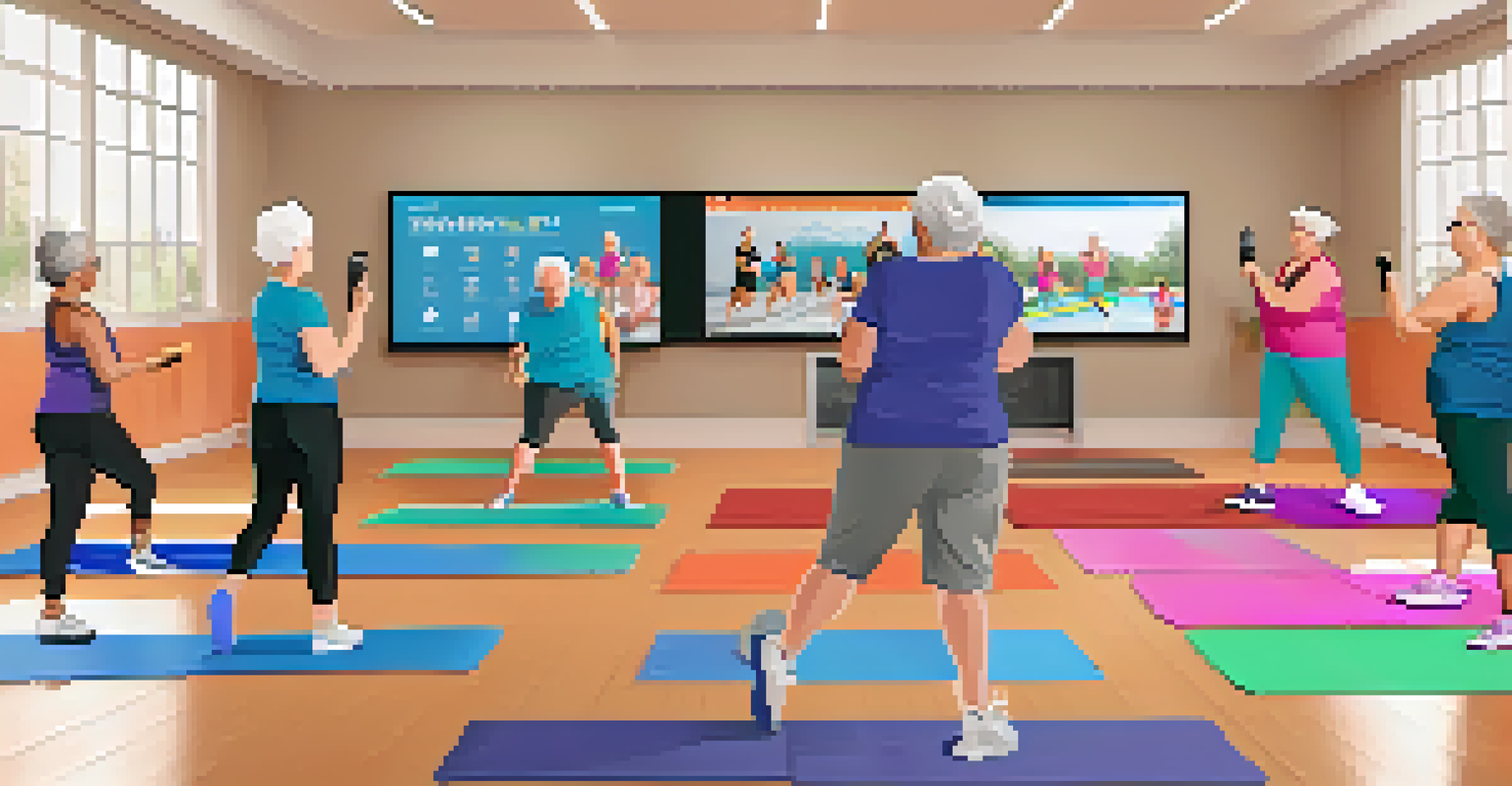Digital Health and Aging: Innovations for Senior Wellness

Understanding Digital Health in Aging Populations
Digital health encompasses a range of technologies aimed at improving health and wellness, particularly for seniors. With the rise of smartphones, tablets, and wearables, older adults can access a wealth of health information and services at their fingertips. This shift is crucial as it empowers them to take charge of their health and stay connected with caregivers and healthcare providers.
The greatest wealth is health.
For instance, telemedicine has become a game-changer for seniors who may struggle with transportation. They can consult with their doctors from the comfort of their homes, which not only saves time but also reduces stress. Moreover, wearable devices can track vital signs, alerting users and their families about potential health issues before they escalate.
As we delve into the innovations in digital health for aging populations, it’s essential to recognize the importance of user-friendly designs. Technologies tailored to fit the needs of seniors can significantly enhance their engagement and overall wellness.
Telehealth: Bridging the Gap in Care Access
Telehealth has revolutionized the way seniors access healthcare services, especially in rural areas where medical facilities may be far away. Virtual appointments mean that seniors can speak with healthcare professionals without the burden of travel, making it easier for them to manage chronic conditions. These remote consultations can be just as effective as in-person visits.

Additionally, telehealth platforms often come equipped with features like medication reminders and follow-up notifications, which are vital for seniors who may have multiple prescriptions. This technology not only improves adherence to treatment plans but also fosters a proactive approach to health management. It encourages seniors to reach out when they need help, rather than waiting for an in-person visit.
The convenience of telehealth also extends to mental health services. Seniors facing isolation can access therapy sessions from home, helping to combat feelings of loneliness and depression. This accessibility is a crucial aspect of holistic wellness in the aging population.
Wearable Technology: Monitoring Health in Real-Time
Wearable technology, such as fitness trackers and smartwatches, offers seniors a way to monitor their health in real-time. These devices can track heart rate, physical activity, and even sleep patterns, providing valuable data that can be shared with healthcare providers. This continuous monitoring helps in identifying health trends and potential issues early on.
Technology is best when it brings people together.
For instance, a senior wearing a smartwatch may receive alerts if their heart rate exceeds a normal range, prompting them to seek medical advice. This proactive approach not only helps in managing existing health conditions but also encourages a more active lifestyle. As seniors become more aware of their physical activity levels, they may be motivated to engage in regular exercise.
Moreover, the social aspect of wearables shouldn’t be overlooked. Many devices allow users to connect with family members or friends, creating a supportive community that encourages positive health behaviors. This combination of technology and social engagement can significantly enhance a senior's quality of life.
Mobile Health Apps: Empowering Seniors with Information
Mobile health apps are another significant innovation that empowers seniors to take control of their health. These apps can assist with everything from medication management to tracking symptoms and making appointments. By having health information readily available, seniors can make informed decisions about their care.
For example, apps that remind users to take medications at specific times can reduce the risk of missed doses. This simple yet effective tool can be a lifesaver for many seniors managing multiple medications. Additionally, health tracking features can provide valuable insights for healthcare providers, leading to more personalized care plans.
These apps also offer features that promote wellness, such as guided exercises or meal planning. By integrating these elements into daily routines, seniors can foster better health habits and improve their overall well-being. The accessibility of information at their fingertips is a powerful motivator for many.
Social Connectivity: Combatting Loneliness with Technology
One of the most pressing issues facing seniors today is social isolation, which can lead to serious health consequences. Digital health innovations play a crucial role in combatting loneliness by facilitating connections with family, friends, and communities. Video calls, social media, and messaging apps allow seniors to stay engaged and maintain relationships, regardless of distance.
For instance, platforms like Zoom and Skype have gained popularity among seniors, enabling them to participate in virtual family gatherings or community events. This technology helps bridge the gap created by physical distance, fostering emotional well-being and reducing feelings of isolation. Regular social interaction is essential for mental health, and technology makes it more accessible than ever.
Moreover, many organizations now offer online classes and workshops specifically designed for seniors, ranging from art to fitness. These opportunities not only provide social engagement but also stimulate cognitive function and creativity. By embracing technology, seniors can enhance their social connections and enjoy a more fulfilling life.
Artificial Intelligence: Enhancing Personalized Care
Artificial intelligence (AI) is transforming the landscape of healthcare for seniors by enabling personalized care solutions. AI-driven tools can analyze vast amounts of data to tailor health recommendations based on individual needs. This means that seniors can receive customized health plans that take into account their unique medical histories and lifestyle choices.
For example, AI can help predict potential health risks by analyzing patterns in a senior's health data. This predictive capability allows healthcare providers to intervene early, preventing complications and ensuring timely treatment. The result is a more proactive and individualized approach to health management.
Furthermore, AI can enhance the experience of using digital health technologies. Voice-activated assistants, for instance, can help seniors navigate health apps and devices without needing extensive technical knowledge. This ease of use encourages greater adoption of digital health tools, ultimately leading to improved health outcomes.
Challenges and Considerations in Digital Health Adoption
While digital health offers numerous benefits for seniors, there are challenges that need to be addressed to ensure widespread adoption. One significant obstacle is the digital divide; not all seniors have access to the necessary devices or internet connectivity. This disparity can lead to inequities in health outcomes, as those without access may miss out on essential services.
Additionally, some seniors may face difficulties in using technology due to lack of familiarity or fear of making mistakes. It’s crucial to provide adequate training and support to help them navigate digital health tools confidently. Family members and caregivers can play an important role in this process by offering guidance and encouragement.

Lastly, privacy and security concerns are paramount in the digital health space. Seniors must feel assured that their personal health information is protected when using online services. Building trust in these technologies is essential for fostering engagement and ensuring that seniors can fully benefit from the innovations available to them.
The Future of Digital Health for Seniors
As technology continues to evolve, the future of digital health for seniors looks promising. Innovations like virtual reality and advanced telehealth platforms are on the horizon, offering even more ways to enhance wellness and quality of life. These advancements aim to create a more integrated approach to healthcare, where seniors can receive comprehensive support tailored to their needs.
For example, virtual reality could be used for therapeutic purposes, helping seniors engage in physical activities or cognitive exercises in an immersive environment. As these technologies become more accessible, they hold the potential to transform the aging experience, making it more enjoyable and fulfilling.
Ultimately, the goal of digital health innovations is to empower seniors to live healthier, more connected lives. By embracing these technologies and addressing the challenges that come with them, we can create a future where every senior has the tools they need to thrive.